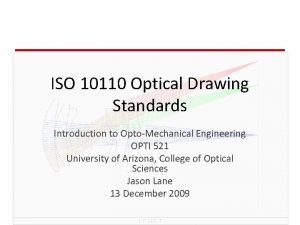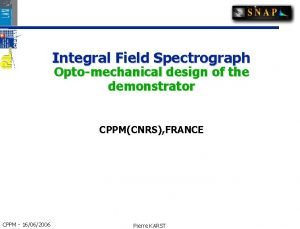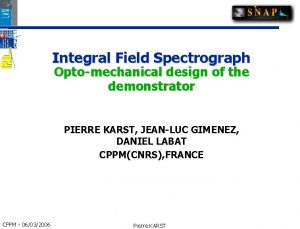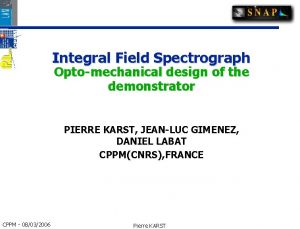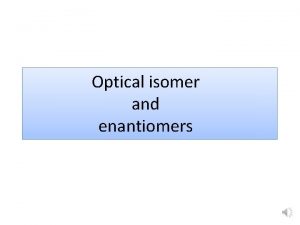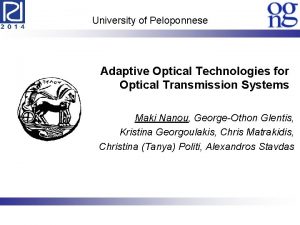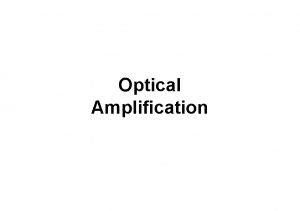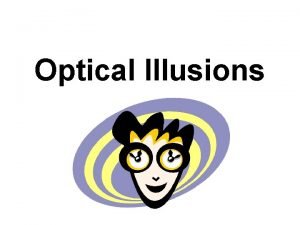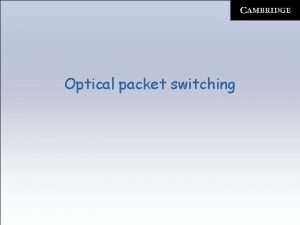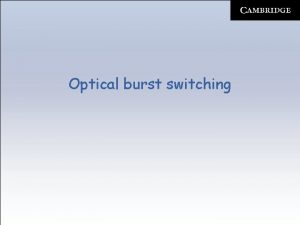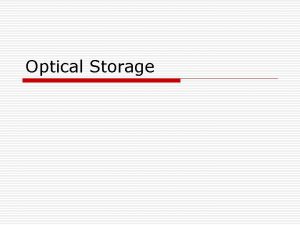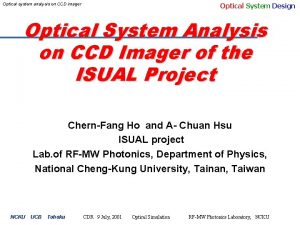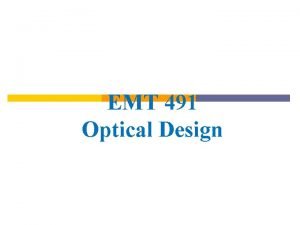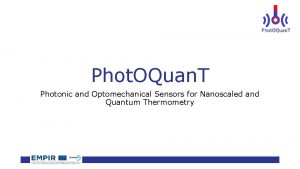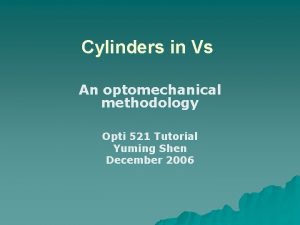Optomechanical Design and Analysis of Adaptive Optical Systems























- Slides: 23

Optomechanical Design and Analysis of Adaptive Optical Systems using FEA and Optical Design Software Victor Genberg, Keith Doyle, Gregory Michels Sigmadyne, Inc. 803 West Avenue, Rochester, NY Phone: 585 -235 -7460 email: genberg@sigmadyne. com 5/8/03 Copyright Sigmadyne, Inc. 1

Integrated Optomechanical Analysis Interpolated Temperatures Interface Programs Zernike Fitting Interpolation De Su fo rfa rm ce at io ns c pti o-O erm ts Th Effec Steady-State & Transient conduction convection radiation Structural Analysis Bi S re tre S fri ss Op tru ng tim ctu en iza al ce tio n Thermal Analysis static & dynamic linear / nonlinear stress displacement shock & vibration thermo-elastic inertial buckling Optical Analysis Optical Performance Metrics 5/8/03 Copyright Sigmadyne, Inc. Wavefront Analysis Point Spread Function Modulation Transfer Function Encircled Energy 2

Integrated Opto. Mechanical Analysis Example Telescope: Must pass structural distortions to optical model for analysis Finite Element Model 5/8/03 Optical Model Copyright Sigmadyne, Inc. 3

Zernike Polynomials • Polynomial series with two real variables, r and q r r - dimensionless normalized radius - polar angle Anm & Bnm - polynomial coefficients • Standard Zernike polynomials (See Born & Wolf, Principles of Optics) – use as many terms as required to represent the data • Fringe Zernike polynomials are a subset of the Standard Zernikes – include higher-order symmetrical terms (r 10 & r 12) that are more important to wavefront propagation; eliminates the higher-order azimuthal terms 5/8/03 Copyright Sigmadyne, Inc. 4

Zernike Surfaces +1. 0 -1. 0 Bias/Piston: 1 Power/Defocus: 2 r 2 -1 5/8/03 Tilt: rcos( ) / rsin( ) Pri-Astigmatism / 2 r 2 sin(2 ) 2 r 2 cos(2 ) Copyright Sigmadyne, Inc. 5

Zernike Surfaces +1. 0 -1. 0 Pri-Coma: / (3 r 3 -2 r)sin( ) Pri-Trefoil: / r 3 sin(3 ) (3 r 3 -2 r)cos( ) Pri-Spherical: 6 r 4 -6 r 2+1 5/8/03 r 3 cos(3 ) Sec-Astigmatism: / (4 r 4 -3 r 2)sin(2 ) (4 r 4 -3 r 2)cos(2 ) Copyright Sigmadyne, Inc. 6

Integrated Opto. Mechanical Analysis - Current Technology • FEA code (Nastran) => surface deformations • Sig. Fit => Fit Zernikes to FEA data, output in Optics format • Optics code (Code. V) => read Zernikes, calculate system optical response • Disadvantages – requires optical engineer in the loop – analysis process turnaround is slow – can not use in FEA optimization loop 5/8/03 Copyright Sigmadyne, Inc. 7

Why Adaptive Optical System • Optical surfaces are deformed and moved based on measured or anticipated information to compensate for unwanted disturbances • Uses – Fabrication & assembly errors in deployable systems – Thermoelastic & humidity distortion – Atmospheric disturbance in ground based telescopes – Vibrations & dynamic disturbances 5/8/03 Copyright Sigmadyne, Inc. 8

Adaptive Simulation Method - Conceptual • Adaptive Performance Can Be Simulated With Finite Element Analysis – Generate two sets of deformation predictions – Uncorrected disturbances – Actuator influences – Solve for actuator inputs, x 1, x 2, x 3. . . xn, to minimize surface error, E x 1 Input Disturbance x 2 Actuator 1 Actuator 2 xn Actuator n Surface Error – If focus compensation exists elsewhere, terms like 2 r 2 -1 or DR can be added as augment actuators 5/8/03 Copyright Sigmadyne, Inc. 9

Adaptive Analysis - Current Technology • • FEA code => surface distortions FEA code => actuator influence functions Sig. Fit => read FEA data, calculate actuator force to correct that surface Optics code => read Sig. Fit data, calculate system response • Disadvantages – Error correction for that single surface, not system response – Not correcting other optical surfaces effects – Can not combine multiple adaptive surfaces • To correct system level effects, the system wavefront error must be related back to the adaptive optic as an equivalent surface distortion. 5/8/03 Copyright Sigmadyne, Inc. 10

Integrated System Analysis - New Technology • Optics code => system response sensitivity due to unit Zernikes at each surface • FEA code => surface distortions of all surfaces • FEA code => influence functions for all actuators (if adaptive) • Sig. Fit => calculate system response – fit Zernikes to FEA distortions of each surface – multiply by system sensitivities to get system response • Sig. Fit => calculate corrected system response (if adaptive) – fit Zernikes to FEA influence functions – calculate actuator forces to minimize system error • Advantage – speeds up analysis turn around – using system level performance generates superior designs 5/8/03 Copyright Sigmadyne, Inc. 11

Integrated System Analysis - New Technology • Optical surfaces: n = 1 to S • Zernike in/surface: j = 1 to Z • Load case number: i = 1 to L Number adaptive surfaces: t = 1 to T Zernike out/system: k = 1 to Z Actuator number: m = 1 to M • Sensitivity matrix = Zernike out (k) for Zernike in (j) at surface (n) = Skjn • Disturbance fit = fit each load case (i) with Zernike (j) at surface (n) = Cjin • Actuator influence = fit with Zernike (j) at surface (t) = Bjmt • System response = Zernike (k) at output location (0) for load case (i) = Zki 0 5/8/03 Copyright Sigmadyne, Inc. 12

Integrated System Analysis - New Technology • System level response = Zernikes at output (ie Exit Pupil) Where S is the Zernike sensitivities from Code V Skjn = matrix of size (Z x N) and C is the Zernike fit to FEA deformations for each load case Cjin = matrix of size (Z x L x N) Resulting Zo is reported along with Surface RMS and Peak-Valley Output a visualization file showing net response at output location 5/8/03 Copyright Sigmadyne, Inc. 13

Integrated System Analysis - Adaptive - New Technology • System level response at Output location due to Actuators Where B is the Zernike fit to Actuator influence functions Bjmt = matrix of size (Z x M x T) Define system level error 5/8/03 E as Copyright Sigmadyne, Inc. 14

Integrated System Analysis - Adaptive - New Technology Minimize System Error with respect to Actuator forces Solve resulting linear system for A 5/8/03 Copyright Sigmadyne, Inc. 15

Integrated System Analysis - Example: Telescope Finite Element Model 5/8/03 Optical Model Copyright Sigmadyne, Inc. 16

Integrated System Analysis - Example Adaptive PM (9 force actuators in red, 3 displacement actuators in blue) 5/8/03 Copyright Sigmadyne, Inc. 17

Integrated System Analysis - Example • Load Case: 1 g along optical axis • Added 5 l of astigmatism on SM (represents a thermal distortion) • PM sits on 3 points (displacement actuators) – 1 g distortion = 4. 62 l RMS – mostly trefoil = 12. 5 l • SM sits on 3 edge points (with 5 l astigmatism added) – 1 g distortion = 2. 18 l RMS – trefoil = 2. 0 l + – added astigmatism = 5. 0 l = • Note: Surface distortions have a doubling effect on reflected wavefront error 5/8/03 Copyright Sigmadyne, Inc. 18

Integrated System Analysis - Example No Correction PM SM Sys 5/8/03 PM Correction Sys Correction RMS= 4. 62 l RMS= 0. 11 l RMS= 2. 18 l RMS= 11. 25 l RMS= 4. 31 l RMS= 0. 23 l Copyright Sigmadyne, Inc. 19

Integrated System Analysis - Example • Correcting PM disturbance only – Adaptive PM reduced PM error – Did not correct SM error, so SM effects still in System error • Correcting System response – Adaptive PM corrected PM error and the SM error – Resulting System error greatly reduced 5/8/03 Copyright Sigmadyne, Inc. 20

Integrated System Analysis -Example: Compare Sys Response with Code. V 5/8/03 Copyright Sigmadyne, Inc. 21

Summary • Sig. Fit’s new System Level Analysis allows more rapid turn around of analyses – Optics engineer needed up front to get sensitivities • Design and analysis under control of structural engineer – Can optimize on system level response – Reduces the need to budget each optic separately • Improves and simplifies system level analyses – Can correct multiple surfaces’ effects with single adaptive optic – Can combine multiple adaptive optics to correct system response – More accurate & useful than correcting a single surface’s effect • User features – Visualization plots of System Level Response • Future development – Add System Level Response to Sig. Fit dynamics – Add System Level Response to Sig. Fit optimization equations for Nastran 5/8/03 Copyright Sigmadyne, Inc. 22

References Genberg, V. , Sigfit Version 2003 -r 1 Reference Manual, Sigmadyne, Inc. , January, 2003 Doyle, K. , Genberg, V. , Michels, G. , Integrated Optomechanical Analysis, SPIE Press, TT 58, October, 2002. Genberg, V. , Michels, G. , "Opto. Mechanical Analysis of Segmented/Adaptive Optics", SPIE Paper 4444 -10, August 2001. Michels, G. , Genberg, V. , "Design Optimization of Actively Controlled Optics", SPIE Paper 4198 -17, November 2000. 5/8/03 Copyright Sigmadyne, Inc. 23
 When to use sdlc
When to use sdlc Systems analysis & design in an age of options pdf
Systems analysis & design in an age of options pdf Gantt chart system analysis and design
Gantt chart system analysis and design Systems analysis and design in a changing world
Systems analysis and design in a changing world Systems analysis and design in a changing world
Systems analysis and design in a changing world Systems analysis and design alan dennis
Systems analysis and design alan dennis System analysis and design
System analysis and design Structured system analysis and design method
Structured system analysis and design method Modern systems analysis and design
Modern systems analysis and design Modern systems analysis and design
Modern systems analysis and design Kendall and kendall system analysis and design
Kendall and kendall system analysis and design System analysis and design dennis
System analysis and design dennis Systems analysis and design alan dennis
Systems analysis and design alan dennis Systems analysis and design alan dennis
Systems analysis and design alan dennis Systems analysis and design alan dennis
Systems analysis and design alan dennis Systems analysis and design alan dennis
Systems analysis and design alan dennis Systems analysis and design alan dennis
Systems analysis and design alan dennis Systems analysis and design alan dennis
Systems analysis and design alan dennis Structured systems analysis and design method
Structured systems analysis and design method Radar systems analysis and design using matlab
Radar systems analysis and design using matlab Object-oriented systems analysis and design using uml
Object-oriented systems analysis and design using uml A modern approach to systems analysis and design
A modern approach to systems analysis and design Patched-up prototype
Patched-up prototype Systems analysis and design in a changing world
Systems analysis and design in a changing world





























